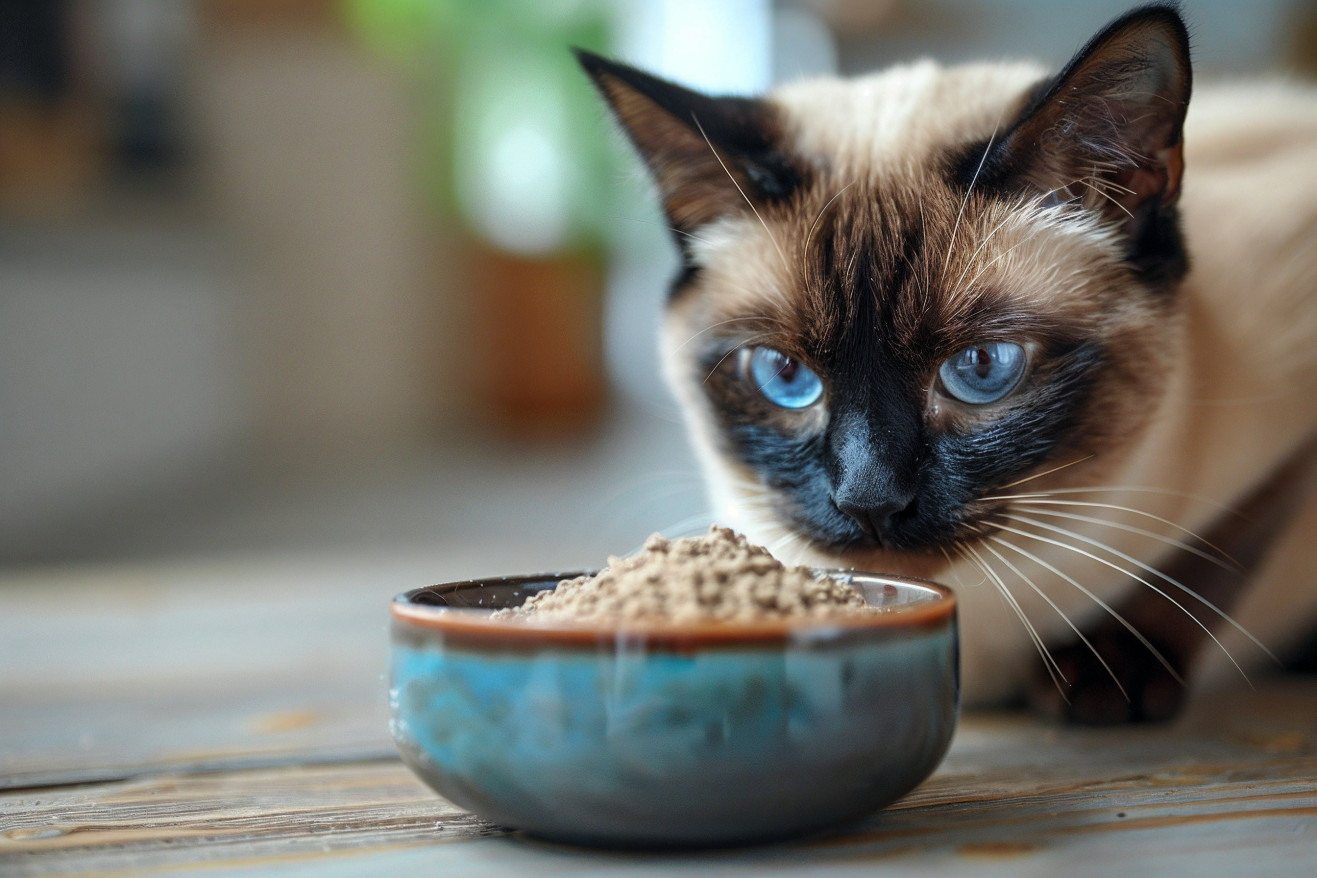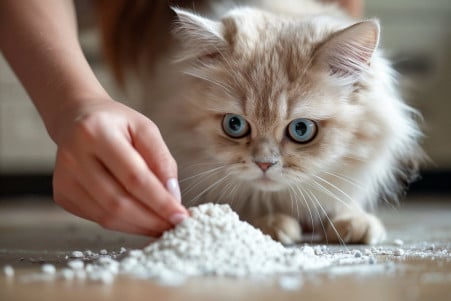Is Diatomaceous Earth Safe for Cats? An Expert Safety Guide
2 March 2024 • Updated 2 March 2024

While diatomaceous earth is known for its pest control properties, what does it mean for your furry feline friends? According to vets, food-grade diatomaceous earth is safe for cats and is even used for deworming and flea control.
However, it’s important to make sure that cats aren’t inhaling it, consuming it in large amounts, or having it applied to their skin, as all of these things can lead to respiratory and skin irritation. Before using diatomaceous earth on your cat, always talk to your vet.
To give you a 360-degree view, we’ll look at a variety of studies and information from veterinary science, toxicology reports, and regulatory agency standards. We’ll go over the different types and uses of diatomaceous earth, its potential health uses, and known hazards, so you can have a well-rounded view and make the best choices for your cat’s health and safety.
Is diatomaceous earth safe for cats?
Diatomaceous Earth Grades
Diatomaceous earth (DE) is not a one-size-fits-all solution. Different grades, including food-grade, pest control-grade, and pool-grade, are intended for different uses. DiatomaceousEarth.com only recommends food-grade DE, which is tested to meet the standards of the Food Chemicals Codex, for uses with cats, including as a deodorizer and flea control. Meanwhile, pool-grade DE is heat-treated, which changes its chemical composition and makes it unsafe for use in homes and with pets.
Knowing and using the right grade of DE is important for your cat’s safety. Food-grade DE is the only grade that should be used for any cat-related purpose because it is tested to meet the standards of the FCC, which means it’s safe for humans and animals to consume. While pest control-grade DE is tested by the Environmental Protection Agency to ensure it meets safety standards, it is not tested to meet food-grade standards.
Proper labeling and adherence to regulatory standards are important to make sure DE isn’t misused in a way that could be harmful. For example, pool-grade DE can be dangerous because of its higher crystalline content. Using a grade of DE that’s regulated and appropriate will help ensure the health and safety of your cats.
How Diatomaceous Earth Affects Cats
PF Harris notes that diatomaceous earth works by a mechanical action, with the sharp edges of the microscopic particles cutting into and drying out insects on contact. This mechanical action works just as well indoors and outdoors, as long as the DE stays dry.
However, for cats, the abrasive nature that makes DE such an effective insecticide can also be problematic. Skin contact with DE can cause dryness and irritation, and inhaling DE can cause respiratory problems.
The National Pesticide Information Center explains that while amorphous DE can cause lung inflammation in humans, the inflammation is mild and reversible. However, cats, who have more sensitive respiratory systems, may be at risk for similar or more serious issues. In addition, the dust from DE can irritate a cat’s sensitive mucous membranes in the eyes and respiratory system.
Because of these potential issues, cat owners need to be careful when using DE to make sure that cats don’t inhale the dust or have prolonged contact with it on their skin. The next section will cover the regulatory and health expert views on diatomaceous earth that help determine how it can be used safely, which can help provide a roadmap for using it responsibly.
How Diatomaceous Earth Is Viewed by Regulatory Agencies and Medical Professionals
When it comes to evaluating the safety of diatomaceous earth (DE) for use with cats, it’s helpful to understand how regulatory agencies and medical professionals view the product.
The Occupational Safety and Health Administration (OSHA) mandates that manufacturers of diatomaceous earth products, especially those that contain amorphous silica with less than one percent crystalline silica, include information about respiratory hazards like silicosis on their Material Safety Data Sheets (MSDSs). Carcinogenicity information must be included if there is a “significant” amount of evidence that supports the claim.
Veterinarians and animal health professionals, including those on the Zoetis Petcare Team, advise pet owners to use DE with care around their pets. While food-grade DE is generally safe for use around pets, it’s important to avoid inhaling or ingesting large amounts of it, as it can cause respiratory and digestive irritation, especially in animals with underlying health issues.
Because of these things, pet owners should be sure to follow guidelines and safety precautions closely. They should also check with their veterinarian before using any new product around their pet. Understanding how DE can be used in practical ways can help ensure that it’s used safely and effectively to help cats stay healthy and well.
Using Diatomaceous Earth for Cats
Diatomaceous earth has even found its way into the world of cat care, especially as a natural dewormer. An article on Cats.com outlines how to use it to control internal parasites when taken in the right doses, which are based on the cat’s weight. However, it’s important to note that you should always talk to a vet before using diatomaceous earth for deworming, as it’s not an FDA-approved treatment for pet diseases.
In addition to internal health, DE’s super absorbent properties are used by manufacturers in cat litter products like EP Minerals’ Blue Ribbon D.E. Premium Cat Litter, which offers excellent moisture absorption and odor control. This can help cat owners change their litter boxes less often, which can help keep the environment cleaner and fresher for both cats and their humans.
When using DE for pest control, it’s important to be careful. A tip on DiatomaceousEarth.com recommends that cat owners use DE in the cat’s environment, not on the cat itself, to avoid skin or respiratory issues.
Cat owners should also make sure the diatomaceous earth is kept dry and away from the cat’s face to avoid inhalation. These examples show that while DE can be helpful, it’s important to use it responsibly and knowledgeably to get the benefits without harming our feline friends.
How Pet Product Safety Is Ensured: Regulatory Overview and Consumer Considerations
The safety of pet products, including diatomaceous earth (DE), is ensured through a complex system of regulations and oversight. The Food and Drug Administration (FDA), as described by the Center for Veterinary Medicine, is a key player in this system, ensuring that animal foods, and by extension pet products, are safe, produced under sanitary conditions, and properly labeled.
State regulations work in tandem with federal oversight, with many states using the guidelines set forth by the Association of American Feed Control Officials to guarantee that pet products meet stringent safety standards.
Pet food manufacturers, in following the Food Safety Modernization Act, as described by the Pet Food Institute, are responsible for making sure their products are safe, meet strict safety regulations, identify potential hazards, and put preventive controls in place.
In order to assess the safety of pet products like diatomaceous earth, consumers should be aware of these regulatory systems. In particular, pet food ingredients are closely monitored and regulated, and there are strict labeling laws in place to make sure that products that are available to consumers have been thoroughly vetted for safety.
Consumers can also look for additional security and transparency by checking Safety Data Sheets, which list hazardous chemical ingredients in compliance with the Hazard Communication Standards.
Consumers are the ultimate decision-makers in this environment and are responsible for understanding the regulations and making safe choices for their cats. In particular, consumers can use the comprehensive regulatory system that oversees pet product safety to help them determine the safety and appropriateness of products like diatomaceous earth for their cats.
Final Thoughts on Cat Safety and Diatomaceous Earth
This deep dive into the relationship between diatomaceous earth (DE) and cats has shown how important it is to understand the differences between the various grades and uses of DE in order to use it safely.
The regulatory agencies have deemed food-grade DE safe for cats as long as it is used responsibly and care is taken to avoid inhalation and overexposure. Whether it is used as a dewormer, a litter additive, or for pest control, it is important to pay close attention to how it is applied.
Pet parents need to be able to make educated decisions about the products they use around their pets, and veterinarians can help with this by providing personalized recommendations for how to use DE as part of a cat’s care routine. By following best practices and safety recommendations, we can make sure that this natural product is used to its fullest potential while keeping our cats safe.
In conclusion, after this in-depth look at diatomaceous earth, it is clear that with careful use and the right advice, this substance can be a valuable part of a safe and effective pet care routine.


